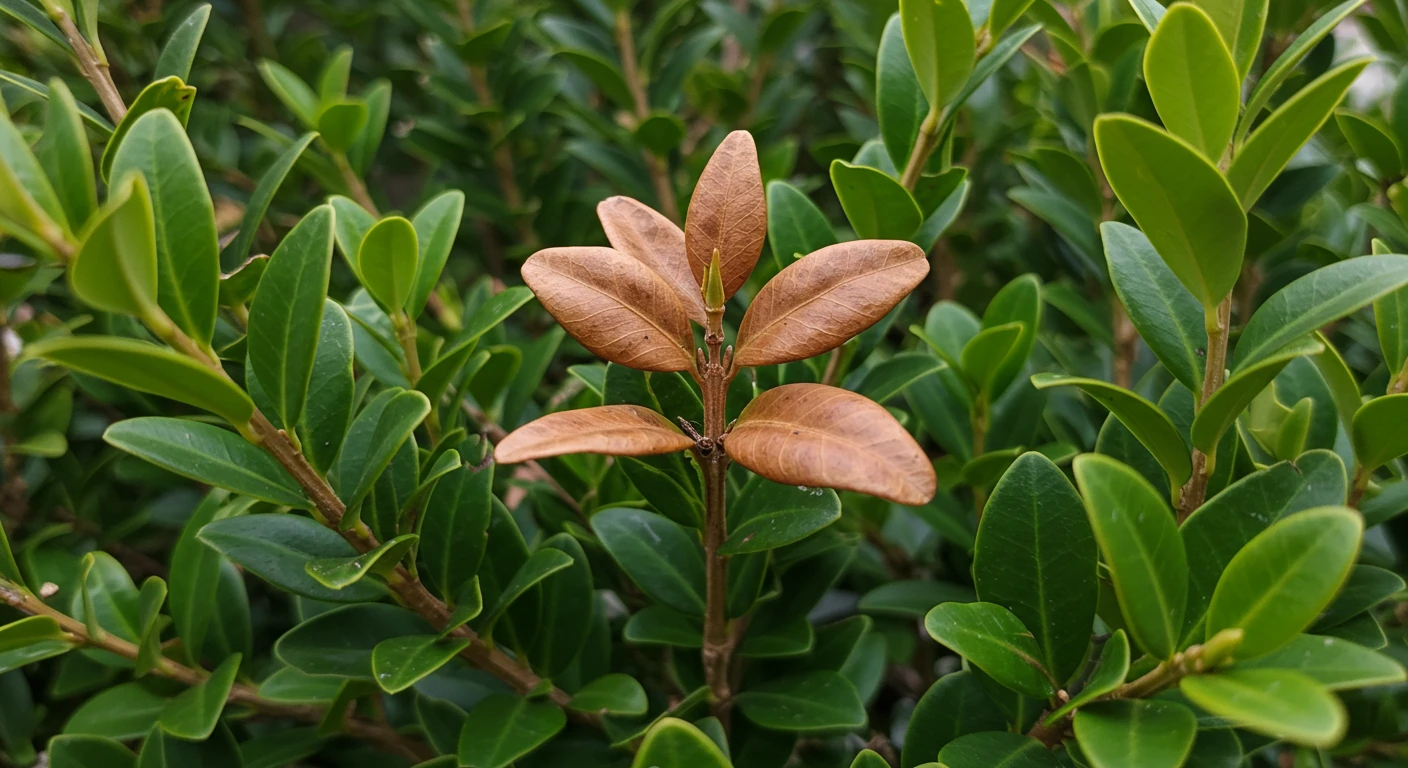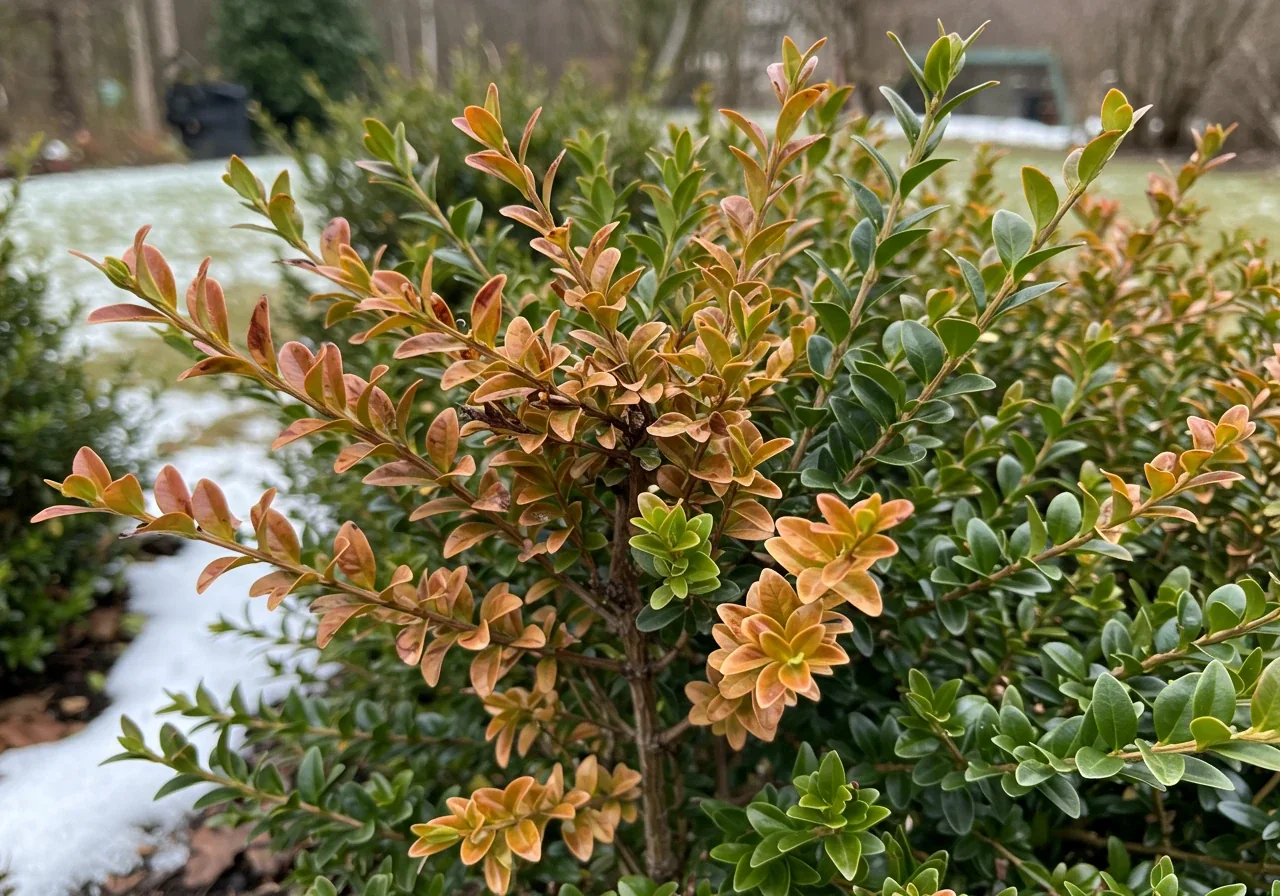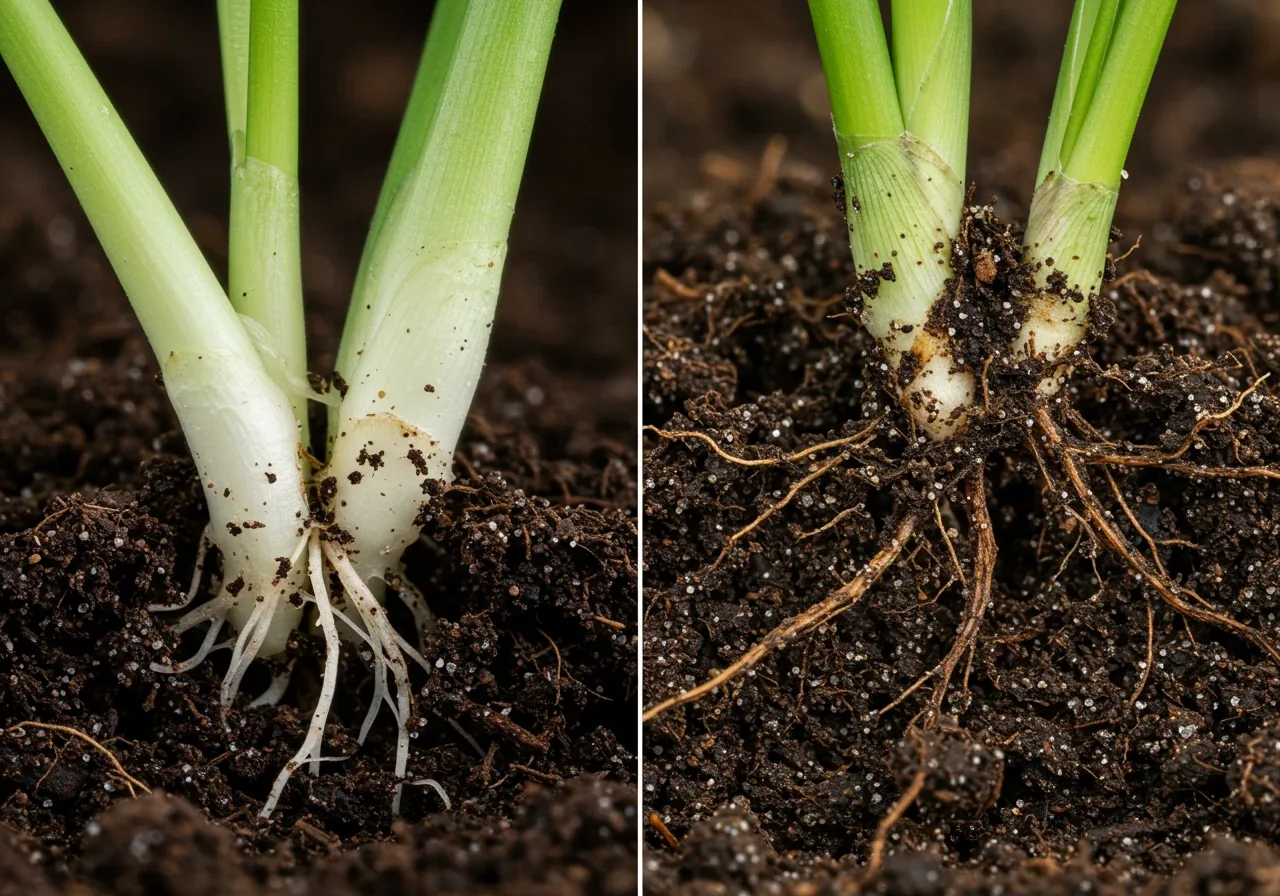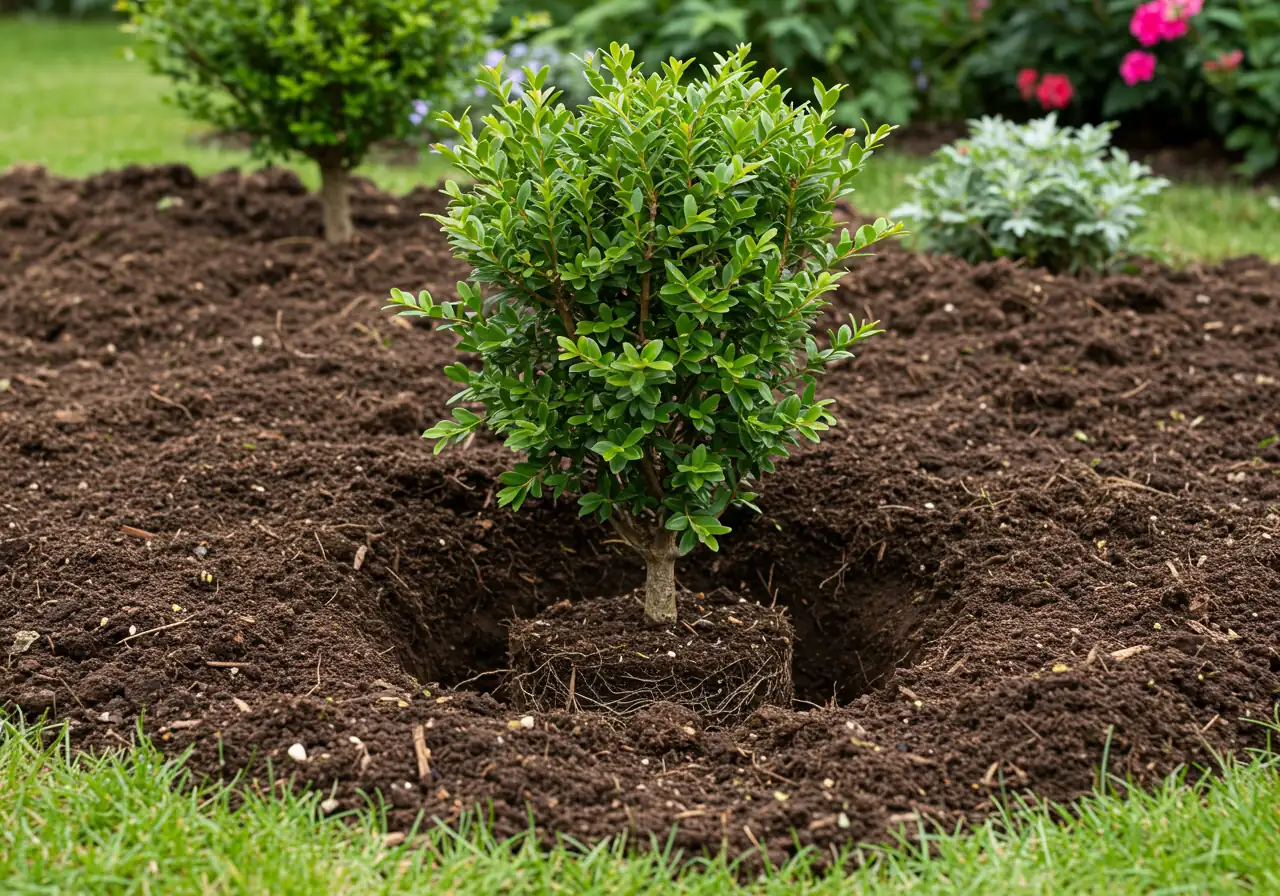Why Nepean Boxwoods Brown: Root Rot Check Tips Summer
Seeing brown on your boxwoods and worried about root rot? Get expert help diagnosing and treating plant issues. Request a Quote Today!
Quick Summary: Brown Boxwood Causes & Checks
- Main Culprit Often Root Rot: Especially in Ottawa's clay soil and after wet periods.
- Key Signs: Browning from bottom/inside out, wilting when soil is wet, mushy/dark roots.
- Don't Confuse With: Winter burn (tips/exposed side), drought (wilts but perks up with water), pests (specific leaf damage).
- Summer Root Check: Gently dig near base, check root color/texture (firm/white = good, mushy/dark = bad), smell soil (earthy = good, sour = bad).
- Prevention is Key: Improve drainage with compost, plant high, water wisely (deeply, infrequently), mulch properly (away from stems).
Introduction: Uh Oh, Brown Boxwoods in Nepean? Let's Dig In!

Hey Nepean neighbours! Taking a stroll around your yard and noticed something… off with your usually reliable boxwoods? Seeing more brown than vibrant green these days? It's a definite "uh oh" moment for anyone proud of their home landscaping. Don't worry, your gardening skills probably haven't deserted you! Before you panic, let's consider a common culprit, especially here in the wider Ottawa region.
After a wet spring or during a damp summer, those poor plant roots can struggle, particularly in the heavier clay soil common from Nepean over to parts of Barrhaven. The likely suspect? Root rot. It sounds serious, and it can be, but understanding the problem is the crucial first step to fixing it (or preventing it next time!). The good news is, you don't need a fancy degree to play plant detective.
This summer season, we’re going to walk you through some practical, easy ways to diagnose what’s happening beneath the surface with your boxwoods. We'll look at the signs and give you actionable tips. Let's dig in and figure this out together!
Boxwoods in the Capital Region: More Than Just Green Cubes
Ah, boxwoods. Let's face it, you see them everywhere around Ottawa, from stately homes in Manotick to tidy front yards in Nepean. They're like the little black dress of the landscaping world – classic, versatile, and always providing structure. Whether clipped into neat hedges, rounded globes, or even left a bit more natural, their evergreen presence gives our gardens shape and colour, especially during those long, grey winters. They're popular for a reason!
But just because they're common doesn't mean they're completely foolproof, especially here in our unique climate. Truth be told, while they look sturdy, they have specific needs. Generally, boxwoods prefer well-draining soil and consistent moisture – not too wet, not too dry. They can handle sun but often appreciate a bit of afternoon shade to protect them from scorching. Simple enough, right?
Well, here’s the tricky part for Ottawa gardening enthusiasts. Our region throws a few curveballs:
- Winter Woes: Our winters can be harsh! Cold temperatures combined with drying winds and freeze-thaw cycles can lead to "winter burn," where the leaves dry out and turn brown. Protecting them from wind and ensuring they are healthy going into the cold season is vital. Think about conducting some simple Nepean Fall Garden Health Checks to spot potential issues early. Adding burlap screens or anti-desiccant sprays can make a big difference, alongside following good advice for Nepean Fall Garden Prep for Winter Colour & Tips.
- Soil Situation: Many areas, including parts of Nepean and Richmond, have heavier clay soil. Clay holds onto water, which isn't great for boxwood roots that hate sitting in soggy conditions. This poor drainage is a major contributor to root rot, especially during wet springs or humid summers. While services like Nepean Spring Lawn Aeration Ottawa focus on lawns, the principle of improving soil structure and drainage is just as important for garden beds around your boxwoods. Amending the soil with compost when planting can help significantly. Explore soil preparation techniques for best results.
- Water Wisely: Because of our summer humidity and potential for heavy rain, overwatering can be just as bad as underwatering, particularly in clay soil. Aim for deep, infrequent watering, allowing the soil surface to dry slightly between sessions. And don't forget about your watering systems as the season ends; proper Nepean Irrigation Winterization to Avoid Pipe Damage is crucial overall yard care.
Understanding these local challenges is the key to keeping your boxwoods looking more like vibrant green gems than sad, brown cubes. If you're struggling to keep yours happy, remember there are comprehensive Landscaping & Gardening Services available to help diagnose problems and keep your entire yard looking its best. You might find options under Garden Maintenance helpful.
Root Rot Explained: The Unseen Enemy Below
Okay, let's talk about the sneakiest villain in the gardening world: root rot. It’s like a secret agent working against your precious plants, operating entirely underground where you can't easily see the damage until it's often too late. Think of it as the unseen enemy below!
So, what exactly is root rot? In most cases, it's a disease caused by various types of fungi or fungus-like organisms (like Pythium or Phytophthora – fancy names, nasty results!). These tiny troublemakers absolutely love overly wet conditions. Imagine mold thriving in a damp corner – it’s a similar idea, but happening to your plant's roots.
Healthy roots are crucial; they're like straws, sucking up water and nutrients to feed the plant. But when root rot fungi move in, they attack these vital roots, causing them to decay, turn brown, and become mushy. Damaged roots can't do their job. They stop absorbing moisture and food, essentially suffocating and starving the plant from the bottom up, even if the soil around them is wet.
The number one accomplice for root rot is too much water. When soil stays soggy for long periods, there's no room for air pockets. Roots need oxygen too! Consistently waterlogged soil creates the perfect low-oxygen, overly moist environment where these harmful fungi flourish.
This is where things get tricky for us here in Ottawa and surrounding areas. Many neighbourhoods, from Nepean over towards Kars or Vernon, often deal with heavy clay soil. Clay soil particles are tiny and pack tightly together, meaning water doesn't drain through quickly. Combine that heavy soil with our typical wet spring thaws or those really humid, rainy summer spells, and you've got a recipe for roots sitting in water – prime conditions for root rot development. Careful planning during Material Selection for Landscaping Projects, like choosing the right soil amendments, can make a big difference in improving drainage from the start.
Often, the first signs you see above ground – yellowing leaves, wilting (even when the soil is wet!), and browning like we see on those struggling boxwoods – are actually symptoms of the root damage happening below. Preventing root rot often comes down to managing moisture through proper watering, ensuring good drainage, and maybe even adjusting your soil composition. Regular Garden Maintenance Services can help monitor plant health and spot drainage issues early. Sometimes, poor drainage is made worse by compacted soil or accumulated debris around the base of plants, areas often tackled during a thorough Nepean Yard Cleanup Service.
Diagnosing root rot definitively can sometimes require a closer look, perhaps even gently examining the roots themselves. If you're seeing worrying signs and suspect this unseen enemy might be lurking, getting a professional opinion can be invaluable. Many comprehensive Landscaping and Gardening Services include plant health assessments. You can even explore getting tailored advice by checking out Estimate and Feedback Options to understand potential solutions for your specific yard. Our Google Business Profile showcases some of our work.
Root Rot Symptoms
- Yellowing/browning often starts low/inside, spreads up/out.
- Plant looks wilted/droopy, even when soil is moist.
- Lower stems near soil might feel soft/mushy.
- Bark may peel easily at the base.
- Roots (if checked) are brown/black, mushy, may smell sour.
- Often follows periods of wet, soggy soil conditions.
Winter Burn Symptoms
- Browning/bleaching concentrated on tips or one exposed side.
- Damage appears late winter/early spring.
- Affected leaves look uniformly tan/reddish-brown, feel dry/brittle.
- Base of the plant and roots are usually healthy.
- Common after harsh winters with wind and sun exposure.
Drought Stress Symptoms
- Browning starts at leaf tips/edges, moves inward.
- Entire plant may look dull, wilted, slightly greyish.
- Plant usually perks up significantly after thorough watering.
- Soil around the roots is noticeably dry.
- Occurs during dry spells without adequate watering.
Decoding the Brown: Root Rot vs. Other Boxwood Bummers

Okay, your boxwood is looking less "evergreen" and more "ever-brown." You know root rot is a possibility, especially after that soggy spring we had across Ottawa. But hold your watering can! Not all brown is created equal in the gardening world. Let's put on our detective hats and figure out if it's truly the dreaded root rot or one of its sneaky look-alikes causing trouble in your landscaping.
It's easy to see brown and jump to conclusions, but playing symptom matchmaker can save you time, effort, and maybe even your plant! Here’s a breakdown of the usual suspects:
- Root Rot: As we learned, this fungal fiend attacks below ground.
- Telltale Signs: Look for yellowing or browning that often starts on the lower or inner branches and spreads outwards and upwards. The plant might look wilted or droopy, even when the soil feels moist (this is a big clue!). In advanced stages, the base of the stems near the soil line might feel soft or mushy, and the bark might peel easily. If you gently dig near the base and find brown, mushy roots instead of firm, white ones, that’s confirmation.
- Winter Burn: Our Ottawa winters can be rough! This is very common.
- Telltale Signs: This damage usually appears in late winter or early spring as the snow melts. The browning is typically concentrated on the parts of the shrub most exposed to harsh winter sun and wind – often just one side or the tips of branches sticking out. The affected leaves tend to look uniformly bleached, tan, or reddish-brown and feel dry and brittle. Unlike root rot, the base of the plant and the roots are usually fine. You might see plenty of this walking around neighbourhoods like Barrhaven after a tough winter.
- Drought Stress: Not enough water can also cause browning.
- Telltale Signs: Browning often starts at the very tips or edges of the leaves and works its way inward. The entire plant might look a bit dull, wilted, or slightly greyish-green. The key difference from root rot wilting is that a drought-stressed boxwood will usually perk up noticeably after a good, deep watering. The soil around a drought-stressed plant will also be clearly dry when you dig down an inch or two. Consistent watering is part of good City Garden Maintenance Service.
- Pesky Pests (like Boxwood Leafminer or Spider Mites): These critters cause different kinds of damage.
- Telltale Signs: Instead of overall browning, look for specific symptoms. Leafminers create small blisters or tunnels within the leaves. Spider mites leave fine webbing and cause tiny yellow dots (stippling) on the leaves. You might need to look closely, but the pattern is usually spotty or specific to individual leaves, not the uniform browning of winter burn or the spreading decay of root rot. Keeping areas clean, perhaps through services like a Metcalf Yard Cleanup Service (even if you're not in Metcalfe, the principle applies!), can reduce hiding spots for pests. For comprehensive cleaning, consider City Property Cleanup Service or Ottawa Property Cleanup Service.
Putting it Together:
Observe the pattern and location of the browning. Check the soil moisture. Consider the time of year. Did the browning appear suddenly after a harsh winter spell, or gradually during a wet period? Gently examining the roots or lower stems can provide crucial clues. If you’re still stumped or dealing with a widespread issue, getting a professional opinion can be invaluable. You can always reach out for an assessment; check out our easy Estimate and Feedback Options to see how we can help. We handle your information responsibly, as outlined in our Privacy Policy. Seeing examples of healthy landscapes in our Transformations Gallery might give you some inspiration for recovery!
Symptom Comparison Table
| Symptom | Root Rot | Winter Burn | Drought Stress |
|---|---|---|---|
| Browning Pattern | Starts low/inside, spreads up/out | Tips or exposed side primarily | Starts at leaf tips/edges, moves inward |
| Wilting | Yes, even with moist soil | No (leaves are dry/brittle) | Yes, but perks up with water |
| Affected Leaves | Yellow then brown, can be soft | Uniformly tan/reddish, dry, brittle | Brown edges, overall dull/greyish |
| Root Condition | Brown/black, mushy, maybe smelly | Usually healthy (firm, white/tan) | Healthy, but soil is dry |
| Timing | Often follows wet periods | Appears late winter/early spring | During dry periods |
Careful observation is your best tool. Happy sleuthing!
Common Causes of Boxwood Issues (Estimated %)
*Illustrative percentages based on common observations in the region.
Summer Root Check: Your Step-by-Step Nepean Boxwood Investigation

Alright, Nepean friends, let's get those hands a little dirty! You suspect root rot might be crashing your boxwood party, but how do you know for sure without accidentally performing plant surgery? Don't fret! This step-by-step check is easier than assembling most IKEA furniture, and definitely less likely to end in frustration (we hope!). Think of yourself as a gentle plant detective on a mission.
Here’s how to conduct your summer root investigation:
- Gather Your Gear: You don't need much. Grab a small hand trowel (like the kind you use for planting annuals) and maybe some gardening gloves if you prefer. A watering can with plain water nearby is also helpful for later.
- Choose Your Spot (Carefully!): You don’t want to dig up the whole plant! Pick a spot near the base of the boxwood, but slightly outside the main stem clump, within the "drip line" (the area under the outermost branches). This is where the feeder roots, often the first affected, usually hang out.
- Gentle Excavation: Think finesse, not brute force. Use your trowel to gently remove the top layer of soil or mulch. Then, carefully dig down a few inches (maybe 4-6 inches deep) in a small section. You're aiming to expose some of the finer roots without tearing through major ones. Go slow! You're just peeking, not excavating for treasure... unless healthy roots are your treasure, which they kind of are! If the area is overgrown with weeds or debris, clearing that first helps – something often handled during a thorough Ottawa Garden Clean Up Service or even a City Garden Clean Up Service.
- The Visual Inspection: Okay, detective, what do you see?
- Healthy Roots: Look for roots that are whitish, light tan, or creamy in colour. They should feel firm to the touch. Think crisp, like a fresh carrot!
- Suspicious Roots: Root rot often turns roots brown or black. They might look waterlogged and feel soft, mushy, or even slimy. If you gently tug on one, it might break off easily, or the outer layer might slip off, leaving a stringy core.
- The Sniff Test (Yes, Really!): Lean in and take a whiff of the soil you disturbed. Healthy soil usually has an earthy, neutral smell. If you get a whiff of something sour, stagnant, or downright rotten (like bad potatoes), that’s a strong indicator of anaerobic conditions (lack of oxygen) and potential root rot.
- Check Soil Moisture: While you're down there, feel the soil. Is it soggy and waterlogged even though it hasn't rained heavily in days? Consistently wet feet are a major invitation for root rot, especially in the clay soils common around Ottawa and even out towards Russell. Poor drainage might be the underlying issue. Sometimes, broader yard issues contribute, making general upkeep like a City Property Cleanup Service important for overall plant health. Also consider services in nearby areas like Metcalfe Property Cleanup Service.
- Cover Up Gently: Once you've made your observations, carefully push the soil back into place, covering the exposed roots. Pat it down gently – don't pack it hard. Give the area a small drink of water to help the soil settle back around the roots.
What Now? If you found mushy, brown roots and that tell-tale sour smell, root rot is highly likely. If the roots looked healthy, congratulations! You might be dealing with one of the other boxwood bummers we discussed. Severe root rot is tough to cure, but catching it early gives you more options. Sometimes, improving drainage around the plant or adjusting watering habits can help, which might be part of routine City Garden Maintenance Service. If the plant seems too far gone or the problem stems from major soil compaction or drainage issues across a larger area, more significant work might be needed, potentially involving removing the affected plant (perhaps as part of a larger job like a Metcalf Property Cleanup Service handles, regardless of your specific neighbourhood) or even considering regrading or exploring options like professional Sod Installation Services if lawn areas are contributing to water pooling near beds. Need help removing plants? Our Property Clean Up services can assist.
From Diagnosis to Action: Saving & Protecting Your Boxwoods
Okay, you've played detective, done the root check, and the news isn't great. It looks like root rot is the uninvited guest causing havoc with your beautiful boxwoods. Don't throw in the trowel just yet! Depending on the severity, there might be hope. Let's talk about getting proactive – from potential rescue missions to making sure this doesn't happen again.

First Aid for Ailing Boxwoods (Maybe!)
If the root rot seems caught early (only some roots affected, plant still has some vigour), you might be able to attempt a rescue. But let's be honest, it's often a long shot for severely affected plants.
- Improve Drainage STAT: This is non-negotiable. Gently loosen the soil around the base of the plant, extending out to the drip line. Mix in generous amounts of compost or other organic matter to improve structure and allow water to drain away faster. If the plant is in a low spot where water collects, consider carefully lifting and replanting it slightly higher (creating a small berm) once the soil is amended. This is a delicate operation! Proper soil preparation is vital.
- Prune for Airflow: Thinning out some of the inner branches (using clean, sharp pruners!) can improve air circulation around the base of the plant. This helps the soil surface dry out quicker after watering or rain, discouraging fungal growth. Think of it as giving your boxwood a bit of breathing room. Keeping the area clear of fallen leaves and debris also helps – regular tidying, like that included in an Ottawa Garden Clean Up Service or Metcalf Garden Clean Up Service, prevents moisture from getting trapped.
- Water Wisely (If At All): Hold off on watering unless the soil is truly dry several inches down. When you do water, water deeply but infrequently, allowing the soil to dry between sessions.
- Fungicides? Maybe, with Caution: There are fungicides available labelled for root rot pathogens. However, they are often more effective as a preventative measure and less so as a cure for established infections. They won't fix the underlying drainage problem, and results can be mixed. For significant issues, consulting a professional is best before applying chemicals.
If a boxwood looks completely brown, crispy, or the base is clearly rotten, sometimes the kindest (and smartest) action is removal. Trying to save a goner can sometimes allow the disease to spread. Removing heavily infected plants might be part of a larger cleanup effort, similar to tasks handled by a Metcalf Garden Clean Up Service or Marionville Garden Clean Up Service – getting rid of the problem source is key, wherever you are in the Ottawa area.
Prevention: The Best Medicine for Happy Boxwoods
Honestly, avoiding root rot in the first place is far easier than trying to cure it. Here’s how to set your boxwoods up for success, especially considering the clay soil challenges often found from Embrun to Winchester:
Spring Prep (Location & Planting)
Choose spots with good natural drainage. Amend soil heavily with compost. Plant root ball slightly above soil level. Consider professional Garden Install for optimal setup.
Summer Care (Water & Mulch)
Water deeply, infrequently based on soil dryness. Apply 2-3" mulch, keeping it away from stems. Monitor during wet spells. Mulching and Edging services can help maintain this.
Fall Check-up (Cleanup & Drainage)
Ensure area drains well before freeze-up. Clean up debris around base. Check overall health via Nepean Fall Garden Health Checks. Prepare beds with Fall Garden Prep.
Ongoing (Wise Choices & Monitoring)
Select hardy cultivars suited for Zone 5. Regularly inspect for early signs of stress or disease. Tidy up with Ottawa Yard Cleanup Service or City Yard Cleanup Service.
- Location, Location, Drainage! Choose planting spots with good natural drainage. Avoid low-lying areas where water puddles after rain. Observe how water moves through your yard before planting.
- Planting Power: When installing new boxwoods (or anything, really!), amend the soil generously with compost. This improves drainage in heavy clay and water retention in sandy soil. Dig the planting hole 2-3 times wider than the root ball but no deeper. Ensure the top of the root ball sits slightly above the surrounding soil level – this simple step makes a huge difference! If you're redesigning a bed, professional Garden Install services always focus on proper soil preparation and planting depth.
- Watering Wisdom: Deep, infrequent watering is the mantra. Let the soil dry slightly between waterings. Stick your finger down a couple of inches – if it feels damp, wait! Overwatering is the #1 root rot enabler.
- Mulch Moderately: Apply a 2-3 inch layer of organic mulch (like shredded bark) around the base, but keep it pulled back an inch or two from the stems. Mulch piled against the stems traps moisture right where you don't want it. Professional Mulching and Edging ensures this is done correctly.
- Choose Wisely: Some boxwood cultivars are known to be slightly more tolerant of challenging conditions than others. Research varieties suited to Zone 5 and consider asking your local garden centre for recommendations.
- Seasonal Root Health Check-in:
- Spring: Check for winter damage and assess drainage as the ground thaws. Clear away excess debris. Perhaps combine this with a broader Ottawa Yard Cleanup Service to get things tidy. Consider services like those offered for Metcalf Yard Cleanup Service.
- Summer: Monitor watering carefully, especially during wet or humid spells. Check soil moisture before turning on the hose.
- Fall: Ensure the area around your boxwoods drains well before winter freeze-up to avoid roots sitting in icy water.
Dealing with persistent landscaping challenges like root rot can be frustrating. If you've tried these steps and are still struggling, or if the problem seems widespread, don't hesitate to reach out for expert advice. You can always Contact Us to discuss your specific situation and explore professional solutions. Healthy, happy boxwoods are achievable, even in our sometimes tricky Ottawa climate! Check our Thank You page after contacting us.
Key Insights: Your Quick Guide to Happy Boxwood Roots
Okay neighbours, feeling a bit overwhelmed by all the root rot talk? Don't worry! Here are the quick takeaways – your cheat sheet to keeping those boxwood roots happy and your landscaping looking sharp here in Ottawa.
- Drainage is King (Especially in Clay!): Boxwood roots absolutely hate sitting in soggy soil. Since many areas from Nepean to Manotick have heavier clay, improving drainage is your top priority. Amend soil with compost when planting and avoid low, swampy spots. Overwatering is the fast track to root rot!
- Know the Signs – Look Low & Feel: Is the browning starting on the lower, inner branches? Does the plant look wilted even after rain? Gently dig near the base – healthy roots are firm and pale, rotten ones are dark, mushy, and might smell funky (like forgotten potatoes – yuck!).
- Plant Smart, Not Deep: When adding new boxwoods, dig the hole wider, not deeper. Mix in compost and always plant the top of the root ball slightly above the surrounding soil level. This simple gardening trick helps water run off instead of pooling around the base. See our Soil Preparation guide.
- Water Wisely & Mulch Modestly: Ditch the daily sprinkle! Water deeply only when the top few inches of soil feel dry. Keep that mulch layer helpful (2-3 inches) but pull it back an inch or two from the actual stems – don't give moisture a cozy place to hang out right against the plant. Consistent care via Lawn Care and garden maintenance prevents bigger headaches later.
- Prevention Beats Panic: Keeping the area around your boxwoods clean and free of debris reduces fungal hangouts. Regular upkeep, perhaps like the work done in our comprehensive City Yard Cleanup Service, helps maintain good airflow and discourages disease. This principle applies whether you're in the city core or need assistance further out, similar to our dedicated Marionville Property Cleanup Service offers further afield, or even Marionville Yard Cleanup Service.
- Still Stumped? Ask for Backup! Sometimes, you need a helping hand or a professional eye. If your boxwoods are struggling despite your best efforts, or if you're planning a bigger landscaping project, don't hesitate to ask for advice. Feel free to Contact Us to discuss options. Remember to review service details, often covered in our Terms and Conditions, before booking.
Stick to these key points, and you'll be well on your way to happier, healthier boxwoods that make your neighbours green with envy (in a good way!).
Nepean Boxwood FAQs: Your Local Questions Answered
Got questions about keeping your Nepean boxwoods looking their best? You're not alone! We hear lots of great queries from local homeowners. Here are answers to some common ones, keeping our unique Ottawa climate and soil in mind.
Great question! The trick is improving drainage right from the start. Dig a hole two to three times wider than the root ball, but *no deeper*. Mix the soil you removed with plenty of compost – aiming for almost a 50/50 mix helps break up that heavy clay. Good Soil Preparation is absolutely key! Plant the boxwood so the top of its root ball sits slightly *above* the surrounding ground level to encourage water to run off.
Less is often more! That humidity can be deceiving. Instead of watering on a strict schedule, check the soil first. Stick your finger down about two inches near the base. If it feels damp, hold off. If it's dry, water deeply until the soil is moist, then let it dry out again before the next watering. This helps prevent those soggy conditions that lead to root rot.
It's very likely winter burn, quite common from Nepean to Barrhaven! Harsh winds and winter sun can dry out the leaves. If it’s mostly on the exposed side and the base/roots seem fine come spring, that's your culprit. Planting in a spot with afternoon shade or using burlap wraps for exposed plants can really help minimize this cosmetic issue next year.
Yes, definitely prune out any clearly dead branches using clean, sharp shears. Cut them back to where you see healthy growth. This improves airflow and looks tidier. If you find a *lot* of dead stuff or the base looks bad, it might signal a deeper issue like root rot. Sometimes a larger Property Clean Up is needed if several plants are affected or dying.
If more than half the plant looks brown or dead, the base is mushy, or you've tried improving drainage and watering habits with no luck, it might be time. Significant interventions or removals are often best left to professionals. They can assess the situation and handle tasks efficiently, much like the comprehensive work provided by the dedicated Marionville Property Cleanup Service, ensuring the issue doesn't spread.
Keep an eye out for Boxwood Leafminer! You'll see little yellowish blisters or squiggly lines inside the leaves. Psyllids can cause cupping on new leaves. Good air circulation helps prevent fungal spots. Keeping the area tidy is also important; think holistic care similar to what a focused Marionville Yard Cleanup Service delivers, removing debris where pests and diseases might hide, wherever you are in the Ottawa region. Similar cleanup services are available for Metcalf and Ottawa.
Keep Your Nepean Boxwoods Green: Let's Tackle Root Rot Together!
Okay, let's wrap this up! Keeping those Nepean boxwoods looking lush and green really boils down to one crucial thing: happy roots. As we've seen, our sometimes-soggy Ottawa weather and heavier clay soil can make things tricky, turning drainage into the name of the game. Paying attention to how you plant, water, and monitor for those early warning signs is your best defence against root rot ruining your beautiful landscaping.
If you're looking at your boxwoods right now and feeling uncertain, or suspect root rot might already be crashing the garden party, don't hesitate to reach out. We can help diagnose the problem and discuss potential solutions for troubled plants in Nepean, Barrhaven, or surrounding areas like Metcalfe or the City core.
Alternatively, if you're planning new gardening projects or adding boxwoods to your landscape in areas like Manotick, Greely, or Osgoode, let's set them up for success from day one! We offer preventative landscaping services, including proper soil preparation and planting techniques tailored to our local conditions via our Garden Install service.
Here's to healthy roots and gorgeous green boxwoods all season long!

